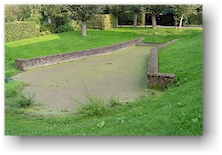|
» Bruges Gate » Haringmarkt » Farm the "Stamper" » Farm Saint Christopher » House "de Grote Sterre" » House Saint John » Damme town hall » Slekkeput » Saint-John's hospital » Medieval waterwell » Waterpumps » Statue J.Van Maerlant » Casemates » Damme town walls » Schellemill » Our Ladies Church » NR Damme town walls » Damse Vaart » Bat reserve » Leopoldcanal » Schipdonkcanal » Damme book village » Museum St-John's hospital » Museum town hall » Museum Schellemill » NR Zwin » Casemates » Slekkeput |
Lock of the "Lieve"
In contrary to Bruges, the city of Ghent did not have direct access to the sea. Out of economic consideration, the city of Ghent decided to dig a canal (the Lieve) to Damme. Not an easy task, especially in the 13th century. Via a number of locks (called "rabotten") the differences in hight were surpassed and the level of water could be maintained to enable navigation. This canal from 1262 was of the utmost importance for the city of Ghent for several centuries: it was the city's gate to the world. This economic artery mouthed in the port of Damme where the cargo from the small riverboats was overloaded to bigger ships that sailed via the Zwin to the North Sea. You can imagine that these activities were also advantageous for the town of Damme. The canal was not very wide; small flatboats and riverboats were used to ship the precious load from and to Ghent. The place where the canal entered the port of Damme was relocated several times in the course of the years. From 1616 on, out of military reason, the canal was guided inside the town via a covered watergate (a casemate). Before, the canal mouthed directly in the Zwin a little north of the town. Via a sluice-gate, the boats were guided inside the port. This sluice-gate was discovered during excavations in 1969. It has been restored now and it gives you a good idea on what the size of the vessels was that were used at that time.
|
|
 Location:
at the end of the Jacob Van Maerlantstraat, 8340 Damme [gps]
Location:
at the end of the Jacob Van Maerlantstraat, 8340 Damme [gps]